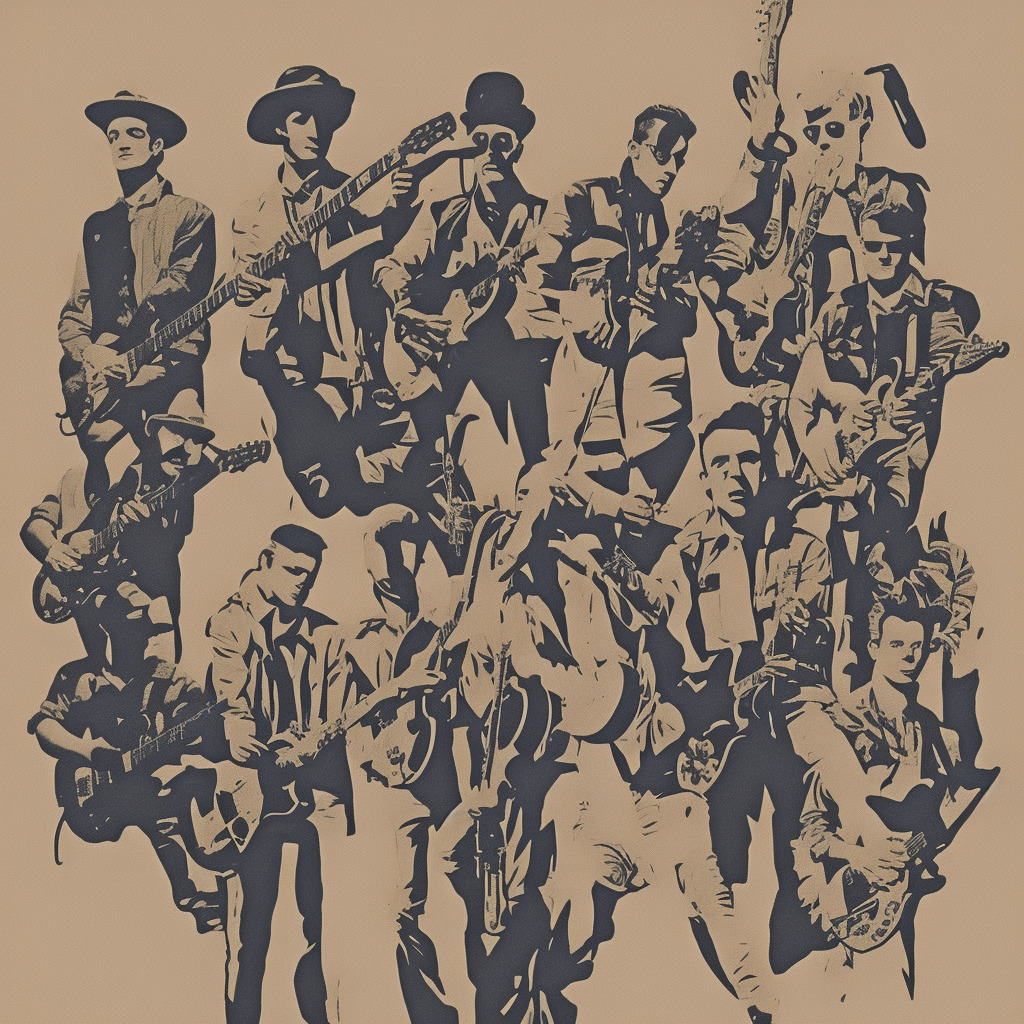A Deep Dive into R.E.M.’s Iconic Hit “Losing My Religion”
R.E.M., the legendary alternative rock band hailing from Athens, Georgia, was a force to be reckoned with throughout the ’80s and ’90s. The group consisted of Michael Stipe (lead vocals), Peter Buck (guitar), Mike Mills (bass), and Bill Berry (drums). The band formed in 1980 and quickly gained a cult following thanks to their unique sound, which combined elements of post-punk and folk rock. However, it wasn’t until the release of their hit song “Losing My Religion” in 1991 that they found mainstream success.
“Losing My Religion” is the first single from their seventh studio album, Out of Time. The song marked a departure from R.E.M.’s previous sound, featuring a distinctive mandolin riff played by Peter Buck. This divergence from their earlier material was a bold move that ultimately paid off, as the song became a massive hit and peaked at number four on the Billboard Hot 100 chart. The track’s introspective lyrics, delivered by Stipe in his signature enigmatic style, resonated with fans who interpreted the song as an anthem for questioning one’s beliefs and identity.
The music video for “Losing My Religion” is just as iconic as the song itself. Directed by Tarsem Singh, the video features surreal and religious imagery that complements the song’s theme. The video went on to win six MTV Video Music Awards in 1991, including Video of the Year, which further cemented R.E.M.’s status as a groundbreaking band.
Despite the success of “Losing My Religion” and Out of Time, R.E.M.’s career was not without its setbacks. The band faced internal struggles and lineup changes over the years, with drummer Bill Berry departing in 1997 due to health issues. The remaining members continued to release albums, but they never quite reached the same level of acclaim as their earlier work. The band eventually disbanded in 2011 after releasing their fifteenth studio album, Collapse into Now.
Although R.E.M.’s later work may not have reached the same heights as their earlier releases, their influence on alternative rock cannot be understated. Bands like Nirvana, Radiohead, and Pavement have cited R.E.M. as a significant inspiration. With a career spanning over three decades and multiple awards under their belt, including three Grammy Awards, R.E.M. will forever hold a place in the annals of rock history. And it’s hard to think of a better representation of their impact than the enduring appeal of “Losing My Religion.”
The Mastermind Behind “Losing My Religion”
The composer behind R.E.M.’s iconic song “Losing My Religion” is none other than the talented Michael Stipe. Not only did Stipe serve as the lead vocalist for the band, but he was also responsible for composing many of their most memorable hits. One such notable track composed by Stipe includes “Man on the Moon,” a tribute to the late comedian Andy Kaufman. Other prominent compositions by Michael Stipe include “Everybody Hurts,” which became an anthem of hope and resilience for many, and “Nightswimming,” a nostalgic and introspective ballad. Stipe’s keen sense of melody and thought-provoking lyrics has helped solidify R.E.M.’s status as one of the most influential bands in the history of alternative rock.
A Closer Look at “Losing My Religion” Lyrics
It’s bigger than you
And you are not me
The lengths that I will go to
The distance in your eyes
Oh no, I’ve said too much
I set it up
That’s me in the corner
That’s me in the spotlight
Losing my religion
Trying to keep up with you
And I don’t know if I can do it
Oh no, I’ve said too much
I haven’t said enough
I thought that I heard you laughing
I thought that I heard you sing
I think I thought I saw you try
Every whisper
Of every waking hour
I’m choosing my confessions
Trying to keep an eye on you
Like a hurt lost and blinded fool, fool
Oh no, I’ve said too much
I set it up
Consider this
Consider this, the hint of the century
Consider this, the slip
That brought me to my knees, failed
What if all these fantasies
Come flailing around
Now I’ve said too much
I thought that I heard you laughing
I thought that I heard you sing
I think I thought I saw you try
But that was just a dream
That was just a dream
“Losing My Religion” is a powerful track from R.E.M.’s 1991 album “Out of Time,” and its lyrics have resonated with listeners for three decades now. Lead singer Michael Stipe has admitted that the song is about unrequited love, inspired by his feelings for someone he cared deeply about but couldn’t express his emotions to.
The lyrics describe the emotional turmoil and frustration of trying to connect with someone who doesn’t share the same feelings, as well as the fear of losing one’s sense of self amid such vulnerability. This theme of unrequited love is universal, transcending time and place, making the song an enduring classic.
At the time of the song’s release, the world was undergoing significant changes, with the fall of the Berlin Wall in 1989, the collapse of the Soviet Union in 1991, and the rise of alternative music, as well as a growing conversation around mental health. “Losing My Religion” managed to capture the zeitgeist of the era, its introspective lyrics reflecting the uncertainty and introspection of the time.
While the phrase “losing my religion” may lead one to believe that the song is about a crisis of faith, Stipe has clarified that it is an idiomatic expression from the southern United States that means “losing one’s temper” or “being at the end of one’s rope.” In the context of the song, this phrase perfectly captures the desperation and helplessness described in the lyrics.
In conclusion, the lyrics of “Losing My Religion” by R.E.M. have stood the test of time not only for their poetic depth and universal themes but also for their relevance to the spirit of the era in which they were written.
A Soaring Chart Success: The Numbers Behind “Losing My Religion”
“Losing My Religion” has undoubtedly left an indelible mark on the music scene since its release on February 19, 1991. Being the lead single from R.E.M.’s seventh studio album, ‘Out of Time,’ the track took the world by storm, garnering remarkable chart success and solidifying the band’s status as one of the most influential acts of the ’90s.
Initial chart positions for “Losing My Religion” were quite promising, with the song debuting at No. 85 on the Billboard Hot 100. It didn’t take long for the track to ascend the charts, eventually peaking at an impressive No. 4 during its 21-week stay on the Hot 100. This made it R.E.M.’s highest-charting single in the United States and a fixture on the airwaves.
The song’s success wasn’t limited to just the U.S. market, as it also made waves across the pond in the United Kingdom. Climbing up the UK Singles Chart, “Losing My Religion” reached a commendable No. 19, marking the band’s first Top 20 hit in the region.
Australia and Canada also embraced R.E.M.’s captivating single, with the track peaking at No. 11 on the Australian ARIA chart and an astounding No. 2 on Canada’s RPM Top Singles chart. Its global appeal was evident, as it found success across various European charts, even earning a No. 1 spot on the Eurochart Hot 100.
“Losing My Religion” didn’t only dominate the charts but also stole the spotlight during award season. The song won several accolades, including two MTV Video Music Awards for Best Art Direction and Best Short Form Music Video, as well as a Grammy Award for Best Pop Performance by a Duo or Group with Vocals in 1992.
The undeniable success of “Losing My Religion” on various charts and in award circuits is a testament to the lasting impact and appeal of the track. Its unforgettable melody, introspective lyrics, and compelling music video have solidified its standing as a defining moment in R.E.M.’s illustrious career and a classic in the annals of popular music.
Awards, Accolades, and Appearances
“Losing My Religion” has been celebrated with multiple awards and accolades since its release in 1991. The song proved to be R.E.M.’s biggest hit to date, reaching #4 on the Billboard Hot 100 chart and #1 on the Modern Rock Tracks chart. The song played a significant role in cementing R.E.M.’s status as a prominent alternative rock band during the 90s.
The song’s critical success is evident from its achievements at the 1991 MTV Video Music Awards, where it won a total of six awards, including Video of the Year, Best Group Video, Best Art Direction, Best Editing, and Best Director for Tarsem Singh. Additionally, “Losing My Religion” received four Grammy nominations in 1992, winning two of them: Best Pop Performance by a Duo or Group with Vocal and Best Short Form Music Video.
“Losing My Religion” has featured in various films, television shows, and video games over the years, contributing to its enduring cultural significance. The song was featured in an episode of the popular TV series “Beverly Hills, 90210,” as well as in the films “Man on the Moon” (1999), “The Kissing Booth 2” (2020), and “Happiest Season” (2020). In the world of video games, the song was included in Guitar Hero World Tour as a playable track, further extending its reach to new audiences.
Throughout the years, several cover versions of “Losing My Religion” have been produced, showcasing the song’s universal appeal and adaptability. Notable covers include those by Tori Amos, Lacuna Coil, and Gregorian. Tori Amos’ cover, featured on her 2001 live album “Strange Little Tour,” presents an emotional and haunting piano-based rendition of the song. Italian gothic metal band Lacuna Coil released their cover version in 2016, offering a heavier and darker take on the classic tune. Meanwhile, the German band Gregorian’s version, which appears on their 2009 album “Masters of Chant Chapter VII,” reimagines the song with a unique Gregorian chant style.
In conclusion, “Losing My Religion” has been a significant part of R.E.M.’s legacy and has been widely recognized for its impact on the music industry. Its diverse array of awards and accolades, as well as its continued presence in various forms of media and the numerous cover versions produced over time, are testaments to the song’s lasting cultural relevance.
Dissecting the Musical Mastery: Losing My Religion
Diving into the technical aspects of “Losing My Religion” reveals the intricate and thoughtful composition process behind this iconic R.E.M. track. The song is primarily written in the key of A minor, with the verses following a chord progression of Am – Em – Dsus2 – G, while the chorus transitions to a slightly different progression of F – Am – G – Am – G. The inclusion of a Dsus2 chord adds a sense of tension and uncertainty, further enhancing the emotional impact of the song.
One of the most distinctive elements of “Losing My Religion” is Peter Buck’s use of the mandolin, which was initially inspired by his fascination with the instrument. The instantly recognizable mandolin riff is built around a series of arpeggiated chords, creating a hypnotic and ethereal atmosphere that masterfully complements Michael Stipe’s introspective lyrics. The mandolin’s unique timbre and the mesmerizing riff help to set “Losing My Religion” apart from other alternative rock songs of the time.
In terms of tempo, “Losing My Religion” clocks in at a moderate pace of approximately 125 beats per minute. This tempo allows the listener to fully absorb the emotional weight of the lyrics and the intricate instrumentation without feeling rushed or overwhelmed. Additionally, the use of a 6/8 time signature lends an unconventional, almost waltz-like quality to the track that further distinguishes it from many other mainstream offerings.
The song also employs a variety of dynamic shifts and instrumental layers that keep the listener engaged throughout its duration. The verses showcase a more restrained arrangement, allowing Stipe’s haunting vocal delivery to take center stage. The chorus, on the other hand, builds to a powerful crescendo, with driving drums, distorted guitars, and soaring backing vocals that create a heightened sense of urgency and catharsis.
Finally, the production of “Losing My Religion” is worth noting as well. The song boasts a polished yet organic sound, with each instrument clearly defined and balanced within the mix. The attention to detail in the recording and mixing process further underscores the artistry and craftsmanship that went into the creation of this unforgettable track.
In conclusion, “Losing My Religion” is a testament to R.E.M.’s ability to craft emotionally resonant and musically innovative songs that resonate with audiences worldwide. The song’s unique blend of traditional and unconventional elements, as well as its masterful composition and production, make it a true standout in the band’s impressive discography.
Visualizing the Torment: The Losing My Religion Music Video
The iconic music video for “Losing My Religion” was directed by Tarsem Singh, who is known for his visually stunning and often surreal filmmaking style. The video premiered on MTV on February 19, 1991, and was an instant hit, earning heavy rotation on the channel.
The “Losing My Religion” music video is notable for its artistic and symbolic imagery, which draws inspiration from various sources, such as the works of Italian artist Caravaggio and Russian filmmaker Andrei Tarkovsky’s 1986 film “The Sacrifice.” The video’s striking visuals were meticulously crafted to reflect the song’s theme of vulnerability and the fear of losing one’s faith.
The video features lead singer Michael Stipe dancing awkwardly and singing the song, interspersed with vignettes of various characters and surreal moments. It includes a compelling scene of a man falling through the air, reminiscent of the biblical fall from grace. The video also showcases Peter Buck, Mike Mills, and Bill Berry playing their instruments inside a dimly lit room, adorned with religious iconography that further emphasizes the theme of faith and questioning.
The production details for the music video, much like the band’s other videos, were relatively low-budget. However, this did not deter R.E.M. or Singh from creating a visually striking and impactful piece of art. The team used creative lighting, set design, and costume choices to bring the video to life, despite financial constraints.
“Losing My Religion” was met with critical acclaim and went on to win several awards, including six MTV Video Music Awards in 1991, such as Video of the Year, Best Group Video, and Best Art Direction. It also snagged a Grammy Award for Best Short Form Music Video in 1992. The music video has left an indelible mark on the history of music videos, with its artistry and thought-provoking visuals continuing to resonate with viewers to this day.
For those interested in fan-made content, numerous tributes and cover versions of the song can be found on YouTube. These videos showcase the creative talents and interpretations of the song by R.E.M.’s dedicated fanbase and attest to the enduring impact of both the song and its accompanying music video.
? Did you know “Losing My Religion” isn’t about faith? It’s actually about feeling at the end of one’s rope ? R.E.M. keeping us on our toes since ’91! ? #MusicTrivia #ClassicAlternative #NowPlaying Read about it: tinyurl.com/zracchn6
Click to Tweet







